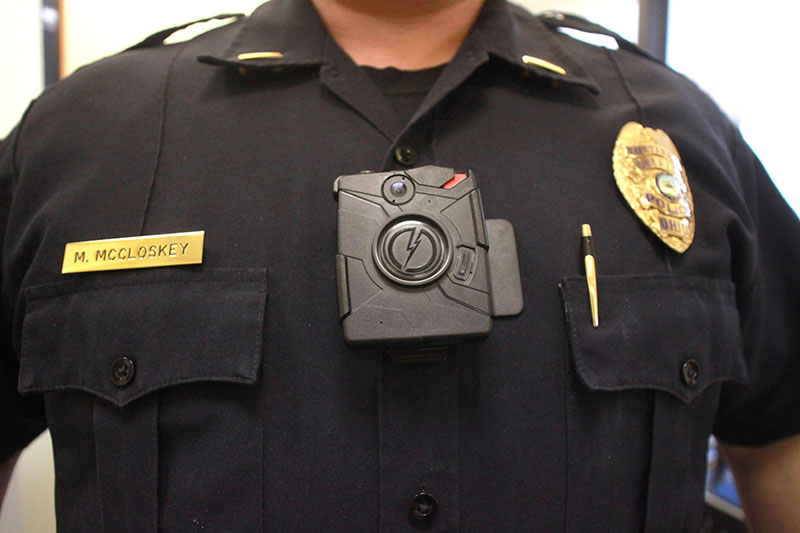OPD to Begin Using Body-Worn Cameras
Lt. Mike McCloskey poses with one of the Oberlin Police Department’s new body cameras. McCloskey said he hopes the camera will pre-emptively improve the officer’s relationship with the public and decrease the number of public complaints.
October 3, 2014
The Oberlin Police Department is preparing to add body-worn cameras to their arsenal of technology this week in an attempt to increase both officer accountability and public trust between officers and city residents.
The cameras, which will soon be worn by every officer in the Department, are modeled to record interactions with the public via a largely hands-off interface. Officers are instructed to turn their camera on at the start of their shift and back off once their shift ends. While they are on, the cameras will video record footage automatically. If an officer wants to record both audio and video, they press one of the camera’s two buttons.
Lt. Mike McCloskey, who will help train officers in the use of their cameras, said he believes that the cameras will help preemptively clarify any future misperceptions regarding officers’ public behavior.
“You’re always going to have citizen complaints, or complaints versus officers, and a lot of it has to do with perspective,” McCloskey said. “If somebody stumbles upon a scene and there were officers involved in a physical struggle with a suspect and they start recording it with a camera, from their perspective it looks like the officers [are] mainly ganging up on that person, but they may not see what precipitated the event.” McCloskey also said that the cameras will “automatically increase accountability,” noting that the cameras will likely be used to record the Department’s most common interactions with the public, such as traffic violations and complaint calls.
Recent events pertaining to police-to-public violence — most prominently the murder of Mike Brown, a black 18-year-old man, by a white police officer in Ferguson, MO earlier this summer — have increased the call for accountability among law enforcement officials across the country. However, some have said that the cameras present a potential for abuse, such as racial profiling or unwanted surveillance.
“One of the issues is going to be that we all kind of take for granted that what we do in public can be seen by others,” Hanni Fakhoury, an attorney with the Electronic Frontier Foundation in San Francisco, told ThinkProgress’s Lauren C. Williams in her article regarding the widespread use of body cameras. “That’s where the real worry is — they’re definitely going to expand its use.”
Other policy analysts have noted several other issues with the technological advance, such as video footage from body cameras ending up online and the possibility that officers will simply turn off their cameras before committing a violation. According to The Atlantic’s CityLab, even when officers are outfitted with body cameras, their departments will often refuse to release the footage.
McCloskey, however, said he believes that the struggle for footage will likely not become an issue for Oberlin’s relatively quiet police force. He does, however, recognize that the officers’ ability to consistently capture footage may present them with some legal dilemmas, especially when they are recording interactions within a private residence.
Asked whether or not his department would use the footage in an attempt to catch any extraneous violations, McCloskey said that it would depend on whether his officers wished to pursue further prosecution.
“We’d be justified in recording those actions, because we’re there on legal authority,” McCloskey said. “If in reviewing the footage we saw a bong, we wouldn’t be legally allowed to go back and enter the residence … [but] we could send that to the prosecutor’s office and we could request a search warrant. It’s definitely a tool that could help us.”
Though McCloskey said he does not expect the cameras to affect his officers’ behavior, numerous studies have shown that the presence of body cameras often drastically alters a police officer’s relationship with the public, namely by reducing their use of force.
One of these studies is currently being conducted by William A. Farrar, the police chief in Rialto, CA. Farrar, who is measuring the effects of body-worn cameras on the relationship between his officers and the public, found that, even with only half of his department wearing cameras, there was an 88 percent decline in public complaints filed against officers. Farrar also found that his officers were 59 percent less likely to use force.
“When you put a camera on a police officer, they tend to behave a little better, follow the rules a little better,” Farrar told The New York Times. “And if a citizen knows the officer is wearing a camera, chances are the citizen will behave a little better.”
While Rialto is one of the only cities in the nation where the use of police-worn body cameras has been studied systematically, experts increasingly predict that body cameras will become a staple in department equipment. A spokesperson for Taser International, a camera manufacturing company that supplied both Rialto’s and Oberlin’s body cameras, reported that their company has recently made contracts with police departments across the country, including ones in major cities such as San Diego, Chicago and Hartford, CT.
“The increase in technology automatically increases officer accountability,” McCloskey said. “Officers have always been in the public eye; we really have to expect to be scrutinized by the public.”
The Oberlin Police Department’s body cameras were funded by a federal grant for law enforcement equipment in which the department was awarded $5,448 to purchase the cameras.

















